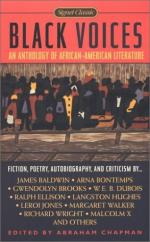|
This section contains 413 words (approx. 2 pages at 400 words per page) |

|
Blacks Summary & Study Guide Description
Blacks Summary & Study Guide includes comprehensive information and analysis to help you understand the book. This study guide contains the following sections:
This detailed literature summary also contains Bibliography on Blacks by Gwendolyn Brooks.
Blacks (1987) is a 512-page collection of Gwendolyn Brooks's poetry and prose, written between 1945 and 1986. Brooks is one of the most influential black writers in contemporary American literature. An accomplished and prolific writer of poetry, fiction, and nonfiction, Brooks has the distinction of being the first African American writer to win a Pulitzer Prize. Critics recognize her as writing in two distinct modes: her early work is formal, characterized by a strict use of rhyme scheme and established poetic forms, while her later work is less controlled and more vernacular, meaning it uses more common, everyday language. Both styles are represented in Blacks. The majority of her writing explores the experiences of blacks within her community, who encounter racism and poverty as part of their everyday lives. Brooks regularly turns to the South Side of Chicago, which she calls "Bronzeville" in many of her books, as a source of inspiration for her work.
Blacks encompasses many of the issues that affect the black diaspora (native Africans and their descendants living outside of Africa), using a variety of distinct perspectives. The book contains selections from eleven of Brooks's books of poetry and an autobiographical novel called Maud Martha. Brooks's approach varies in each section, ranging from the succinct portraits of A Street in Bronzeville to the more political "preachments" of To the Diaspora. Her characters include children, preachers, soldiers, entertainers, the mentally ill, squirrels, and even ghosts. References to historical figures, such as writer Langston Hughes and Black Nationalist leader Malcolm X, interweave with more personal poems that recount the speaker's experiences with prejudice. Many of her poems capture an important moment in a character's life. Together, these voices reflect the black community's diversity as it continues to resist damaging racist stereotypes.
The detailed array of characters and experiences that Brooks captures helps to dismantle stereotypes and makes Blacks more than a mere literary concept piece. In a way it is a tribute, a far-reaching testimony to the variety of events, influences, and perspectives that occur in the black community. The poems in Blacks explore the abstract idea of blackness (as perceived in the larger social context), using concrete events and specific individuals. This approach affects the reader powerfully—Blacks becomes an archive, a definitive history, an encyclopedia, and a collective portrait of a people who have long been stigmatized by others' misperceptions. Brooks's book manages to validate and consolidate the vast experience of blackness without sacrificing the artistic intensity of good poetry.
Read more from the Study Guide
|
This section contains 413 words (approx. 2 pages at 400 words per page) |

|



